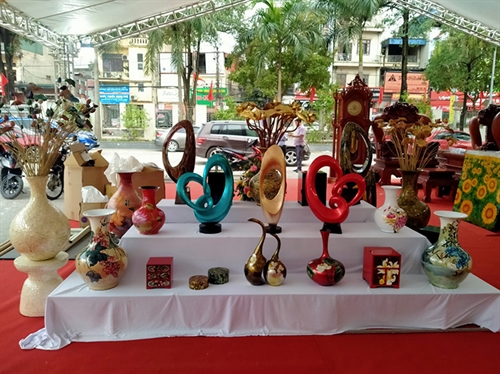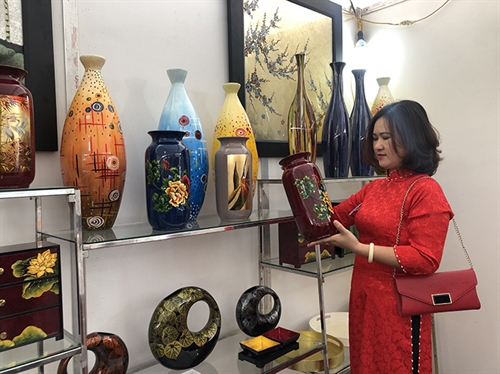Do Thi Nguyet Que
Located about 15 kilometers to the south of the capital city of Hanoi, Ha Thai lacquer craft village in Duyen Thai commune, Thuong Tin district, has become a tourist attraction with well-known lacquer products handcrafted from not only traditional materials like wood, bamboo and ceramics, but also new ones such as plastics, composites and steel.
No one knows exactly when the craft village was set up but the horizontal board and pairs of parallel sentences in black and gold lacquered wood hung in the village’s communal house are said to date back to the 18th century. Villagers believe that the founder of the village was Dinh Cong Thanh who lived in the neighboring village of Duyen Truong. However, it was Dinh Van Thanh, aka Ca Thieng, a skillful artisan, who was recognized as having managed to turn Ha Thai village’s lacquer products into artworks. In 1927, Thanh was invited by the Fine Arts School of Indochina to teach traditional lacquer techniques to students. He was among the first persons to invent modern lacquer painting techniques. In 1937, Thanh joined some famous artists in participating in an international fair in Paris, France, where Vietnamese lacquer was introduced to the world for the first time.
 |
| Lacquer products of Ha Thai craft village__Photo: Nguyen Thi Hoi |
Products of Ha Thai lacquer craft village are plentiful, ranging from ceremonial objects to decorative items and tableware.
The most important material in lacquerware production is sap extracted from the wax tree, Rhus succedanea, a native plant grown in Phu Tho province. Emeritus Artisan Nguyen Thi Hoi told the Vietnam Law & Legal Forum magazine that Ha Thai villagers coat lacquer objects with thin, successive layers of wax tree sap which will help create an airtight, waterproof and glossy surface for the objects. The sap coating also protects wooden items from swelling, warping or splitting once they are exposed to humidity or heat and from insects such as termites or woodworm. Like latex, wax tree sap is harvested by making incisions around tree-trunks and letting the sap flow. Fresh wax tree sap is blended with resin into a mixture which will be strongly stirred with an iron stick and then kept intact in a pot for three days. The black sediment at the bottom of the pot is called son then, which is used to create the black coating of lacquer objects, while the puce liquid floating on the surface may be used as gloss lacquer paint. Nowadays, wax tree sap may be replaced by polycashew oil to shorten the lacquerware making process.
 |
| Lacquer products of Ha Thai craft village__Photo: Tran Viet/VNA |
The making of lacquer pieces by Ha Thai lacquer artisans is a sophisticated and painstaking process, said Do Hung Chieu, the owner of the An Huy Lacquer Art Facility that specializes in making lacquer works for export. It takes about 60 days to make a lacquered object with polycashew oil. However, if applying the traditional method of using wax tree sap, the production process will be prolonged to 90 days.
A high-quality lacquerware item often has a multi-layer coating which sometimes amounts to 18-20 layers. The artisan, first of all, works on the wooden or bamboo armature. With patience, he slowly and carefully applies the first layer of fresh wax tree sap or polycashew oil to the armature and leaves it to completely dry before polishing it with sand paper. Next, he soaks a mesh fabric cloth in the fresh wax tree sap or polycashew oil and attaches the cloth to the armature to make it become a solid block. Then he waits for the surface of the armature to dry and polishes it once again with a view to smoothing out all bumps and filling in small holes and cracks on the surface of the armature.
 |
| Lacquer products of Ha Thai craft village__Photo: Do Phuong Anh/VNA |
The key to achieving a smooth even surface is a thorough job from start to finish. This doesn’t end with applying just fresh wax tree sap. A lacquer object will also be coated with layers made from other materials. While the coating of wax tree sap can help prevent cracks, a layer of wax tree sap mixed with alluvial soil extracts gives the object a shiny surface and a mixture of polycashew oil and kerosene can help increase strength and durability. The object will also be polished with sand paper after each time of coating for it to achieve smooth, even, flawless and waterproof finish. The build-up of these layers forms the base, to which the decoration is then applied.









